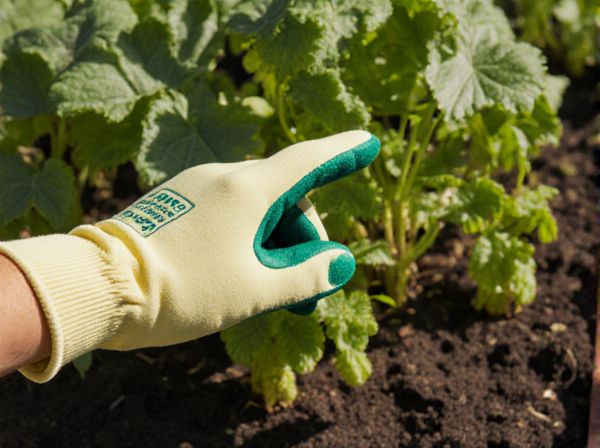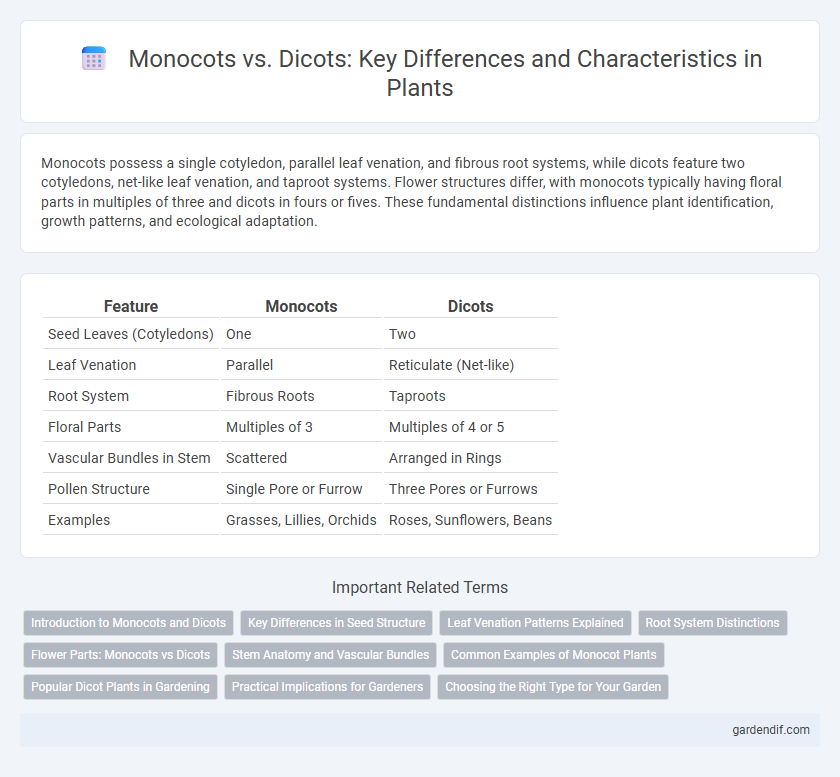
Monocots vs Dicots Illustration
Monocots possess a single cotyledon, parallel leaf venation, and fibrous root systems, while dicots feature two cotyledons, net-like leaf venation, and taproot systems. Flower structures differ, with monocots typically having floral parts in multiples of three and dicots in fours or fives. These fundamental distinctions influence plant identification, growth patterns, and ecological adaptation.
Table of Comparison
| Feature | Monocots | Dicots |
|---|---|---|
| Seed Leaves (Cotyledons) | One | Two |
| Leaf Venation | Parallel | Reticulate (Net-like) |
| Root System | Fibrous Roots | Taproots |
| Floral Parts | Multiples of 3 | Multiples of 4 or 5 |
| Vascular Bundles in Stem | Scattered | Arranged in Rings |
| Pollen Structure | Single Pore or Furrow | Three Pores or Furrows |
| Examples | Grasses, Lillies, Orchids | Roses, Sunflowers, Beans |
Introduction to Monocots and Dicots
Monocots and dicots are two major groups of flowering plants distinguished by their seed structure, where monocots have a single cotyledon and dicots have two. Monocots typically exhibit parallel leaf venation, fibrous root systems, and floral parts in multiples of three, while dicots show reticulate venation, taproot systems, and floral parts in multiples of four or five. These fundamental differences influence plant classification, morphology, and physiological adaptations.
Key Differences in Seed Structure
Monocots have a single cotyledon in their seed structure, while dicots contain two cotyledons, which influences their nutrient storage and germination process. The endosperm is typically retained in monocot seeds, providing essential nutrients during early development, whereas in many dicots, the cotyledons absorb the endosperm nutrients before germination. Seed coat thickness and vascular tissue arrangement also differ, with monocots exhibiting scattered vascular bundles and dicots displaying a ring-like pattern.
Leaf Venation Patterns Explained
Monocot leaves exhibit parallel venation, where veins run vertically and remain equidistant, enhancing efficient nutrient transport along elongated leaf blades. In contrast, dicot leaves display reticulate venation, characterized by a complex network of interconnected veins forming a web-like pattern that supports structural strength and effective photosynthesis. These distinct venation patterns are critical markers for plant classification and play a vital role in adapting to different environmental conditions.
Root System Distinctions
Monocots typically develop a fibrous root system characterized by numerous thin roots spreading from the stem base, enhancing soil anchorage and nutrient absorption. Dicots generally possess a taproot system marked by a primary central root growing deep into the soil with smaller lateral roots branching off, facilitating water access from deeper layers. These root system distinctions significantly influence plant stability, nutrient uptake efficiency, and adaptability to varying soil conditions.
Flower Parts: Monocots vs Dicots
Monocot flowers typically have parts in multiples of three, such as three or six petals, while dicot flowers usually have parts in multiples of four or five. Monocots exhibit floral structures with three sepals, three petals, and six stamens, whereas dicots tend to display four or five sepals, petals, and stamens. This distinction in flower parts is a key feature in identifying monocotyledonous and dicotyledonous plants.
Stem Anatomy and Vascular Bundles
Monocot stems exhibit scattered vascular bundles with no distinct arrangement, while dicot stems display vascular bundles organized in a ring around the pith. In dicots, the presence of a vascular cambium allows secondary growth, thickening the stem, whereas monocots typically lack this cambium and secondary growth. The differences in stem anatomy impact nutrient transport efficiency and structural support in these two major groups of angiosperms.
Common Examples of Monocot Plants
Monocot plants include lilies, orchids, and grasses, which are characterized by having a single cotyledon, parallel leaf venation, and floral parts typically in multiples of three. Corn, wheat, and rice are staple monocot crops essential for global food security, showcasing their agricultural importance. Palm trees and bamboo further illustrate the diversity of monocots in various ecosystems, from tropical to temperate regions.
Popular Dicot Plants in Gardening
Popular dicot plants in gardening include roses, sunflowers, and tomatoes, known for their broad leaves with reticulate venation and floral parts typically in multiples of four or five. These plants feature taproot systems that allow efficient nutrient absorption and are often preferred for their diverse flower structures and fruit production. Understanding the distinct characteristics of dicots helps gardeners optimize cultivation practices for better growth and yield.
Practical Implications for Gardeners
Monocots, such as grasses and lilies, typically have parallel leaf veins and fibrous root systems, making them ideal for ground cover and erosion control in gardens. Dicots, including roses and beans, display net-like veins and taproot systems, allowing deeper soil penetration and better nutrient access for larger plants. Understanding these differences helps gardeners choose appropriate plants for soil type, watering needs, and landscape design.
Choosing the Right Type for Your Garden
Monocots and dicots differ fundamentally in their seed structure, with monocots having a single cotyledon and dicots two, which influences their leaf venation, root systems, and flower parts. Choosing the right type for your garden depends on factors such as soil type, climate, and desired plant characteristics; monocots like grasses and lilies often thrive in well-drained soils, while dicots including beans and sunflowers prefer richer, loamy soils. Understanding these distinctions aids in selecting plants that will flourish, ensuring healthier growth and optimal garden performance.
Monocots vs Dicots Infographic

 gardendif.com
gardendif.com